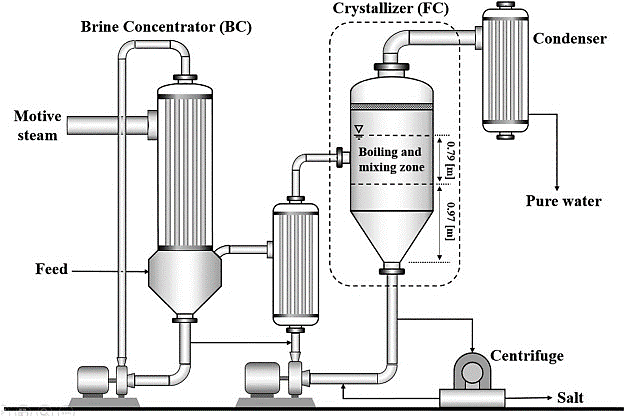
Crystallization is a physical change. Crystallization is the formation of solids from the liquid or gaseous phase. This technique includes obtaining the crystals of a soluble substance from a hot saturated solution and separating the soluble solid from the solution.
To concentrate feed into solid crystals and clean water, crystallizers are used. A progressively harder method for which crystallite sizes are formed from a liquid solution is known as crystallization. Crystallizers can remove liquid wastes completely, resulting in no liquid discharge (ZLD). The process continues and secondary crystallization are the two stages of crystallization. The formation of new crystals is referred to as primary nucleation. Secondary nucleation is the primary stage that results in the mass production of crystals. There are two types of crystallization processes: evaporative crystallization and cooling crystallization.
When daylight is illuminated on to the crystallizer directly from the above mentioned, it really is absorbed by the photothermal coating at the bottom on the system to produce heat. As illustrated in Fig. 1b, the generated heat is then properly conducted on the wall portion owing to your higher thermal conductivity from the aluminum sheet, and thereafter drives the water evaporation and the eventually precipitation of salts solely to the outer wall from the crystallizer.
The ChilledCrys membrane crystallizer system will not be a silver bullet that is suited to all brines. On the other hand, for certain saltwater brines present in industry (e.
The dense salt crust floor layer combined with the salt crystals filling inside the QGF membrane in the case on the concentrated SWRO brine results in the failure on the 3D crystallizer through the long term functions.
Skip to primary written content Thanks for visiting character.com. That you are using a browser Model with constrained help for CSS. To acquire the top knowledge, we endorse you use a far more up to date browser (or convert off compatibility manner in World-wide-web Explorer).
Cooling crystallization is finished with the assistance of oblique heat transfer and beneath a vacuum. The crystallization cooling course of action relies to the dependence with the solubility temperature. From the cooling crystallization system, a few of the options evaporate after which awesome down.
Figure 1a offers a schematic diagram from the 3D photo voltaic crystallizer with an open box framework with 1 base shut. The underside and wall from the crystallizer are bi-layered in configuration. The internal layer is a commercially offered spectrally selective photo voltaic absorber (Alanod®) homogeneously coated on an aluminum sheet and serves as photothermal component. The outer layer in the photo voltaic crystallizer is really a porous and hydrophilic quartz glass fibrous filter membrane (QGF membrane, Merck®) (Fig. S1). The outer QGF membrane, when damp, is instantly stuck onto the backside on the aluminum sheet by means of capillary force without any glue. It wicks brine from your supply brine reservoir and will allow the brine to distribute more than the complete outer floor all through Procedure.
Simultaneously, the backflow impact of brine turned far more pronounced. The effects with the salt concentration distribution simulation are revealed in Figure 8b. The salt focus within the drinking water transportation layer maintained a base-up improve, While the salt focus within Crystallizer Manufacturer Crystallizer For Zero Liquid Discharge System the photothermal layer adjusted from the middle to the edges. The salt concentration from the photothermal layer have been greater from the crystallizers with inclusion angles of sixty° and 90° than in People with thirty° and a hundred and twenty° inclusion angles. A greater salt concentration indicated a craze to much better salt crystallization about the photothermal layer.
Concurrently, the suppressed evaporation with the true seawater brines causes a Considerably smaller detrimental temperature gradient from your outer to interior side on the QGF membrane along with a diminished water flux through the interior side in the QGF membrane to its outer facet, which Advantages the salt ions back again diffusion into the inner aspect. Subsequently, the inner side on the QGF membrane possesses the identical temperature and salt concentration to the outer area, and so encourages salt precipitation Within the membrane, not like the case of pure NaCl brine.
The whole process of vacuum crystallizers is usually made use of as a ongoing and at times as a group. In industry, batch vacuum crystallizers are more well known than steady vacuum crystallizers.
Veolia is a responsible spouse in the event of every distinctive challenge. Combining skilled method development and validation with early scope progress offers the shopper with options for accomplishing each ideal system overall performance and vital enterprise targets.
Editors pick out a small range of content articles a short while ago published while in the journal which they think is going to be significantly
. Really soluble ions is not going to crystallize by chilling, and organics or silica that accumulate require extraction. We've got alternatives and our engineers are ready to run comprehensive assessments on your drinking water troubles.
A variety of HPD® Crystallization systems make it possible for to the creation of specialty and top quality substances being a crystalline item and are usually used inside the procedure of challenging-to-process waste streams.
The hollow cone-shaped buoyant layer was created parametrically by CAD. The center in the buoyancy layer holds the crystallizer, plus the concave groove of your buoyancy layer collects the dislodged salt crystals. The buoyancy layer also functions being an insulator, lessening the warmth transfer between the crystallizer and also the brine. According to the buoyancy method (1) and the specific design and style info on the buoyancy layer, it may be calculated that the amount of brine discharged through the buoyancy layer was 158.